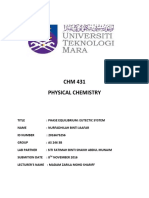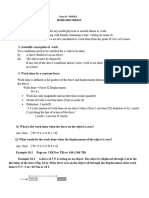9 Science Imp ch11 2 PDF
9 Science Imp ch11 2 PDF
Uploaded by
thrishala ungaralaCopyright:
Available Formats
9 Science Imp ch11 2 PDF
9 Science Imp ch11 2 PDF
Uploaded by
thrishala ungaralaOriginal Title
Copyright
Available Formats
Share this document
Did you find this document useful?
Is this content inappropriate?
Copyright:
Available Formats
9 Science Imp ch11 2 PDF
9 Science Imp ch11 2 PDF
Uploaded by
thrishala ungaralaCopyright:
Available Formats
CBSE
Class 9 Science
Important Questions
Chapter 11
Work and Energy
2 Marks Questions
1. When do we say that work is done?
Ans. Work is done when a force acts on an object and displacement occurs in the direction of
force.
2. Write an expression for the work done when a force is acting on an object in the
direction of its displacement.
Ans.
3. Define 1 J of work.
Ans. 1 J is that work which is done when a force of 1 N is applied on an object and it moves a
distance of 1 m in the direction of force.
4. A pair of bullocks exerts a force of 140 N on a plough. The field being ploughed is 15
m long. How much work is done in ploughing the length of the field?
Ans. Work done
= 2100 J
5. A force of 7 N acts on an object. The displacement is, say 8 m, in the direction of the
force. Let us take it that the force acts on the object through the displacement. What is
the work done in this case?
Ans. Since Work (W)= Force(F) displacement(d)
Material downloaded from myCBSEguide.com. 1 / 8
6. What is the kinetic energy of an object?
Ans. Kinetic energy of an object is a kind of mechanical energy and it is present in that object
due to its state of motion(movement).
7. Write an expression for the kinetic energy of an object.
Ans. Kinetic energy =
where, m = mass of the object, v = velocity of the object(motion)
8. What is power?
Ans. Power is the rate of work done. It is denoted by P.
power = work/time
P = W / t
9. Define 1 watt of power.
Ans. If an agent works at the rate of 1 J/s then the power of that agent is 1 watt (where watt is
the unit of power).
10. An object thrown at a certain angle to the ground moves in a curved path and falls
back to the ground. The initial and the final points of the path of the object lie on the
same horizontal line. What is the work done by the force of gravity on the object?
Ans. For calculating work done there must be displacement but since in this example
vertical displacement is zero (as initial and final points lie on the same horizontal line) so the
work done by force of gravity is zero.
11. A battery lights a bulb. Describe the energy changes involved in the process.
Material downloaded from myCBSEguide.com. 2 / 8
Ans. Chemical energy of battery is changed into heat energy and light energy.
12. Certain force acting on a 20 kg mass changes its velocity from to .
Calculate the work done by the force.
Ans. Work done by the force = change in kinetic energy
= 210 J
13. A mass of 10 kg is at a point A on a table. It is moved to a point B. If the line joining A
and B is horizontal, what is the work done on the object by the gravitational force?
Explain your answer.
Ans. Since work done on the object by gravitational force depends upon change in the
vertical height of the object. Vertical height of the object is not changing as the joining A and
B is horizontal at the same height hence the work done is zero.
14. The potential energy of a freely falling object decreases progressively. Does this
violate the law of conservation of energy? Why?
Ans. It doesn’t violate the law of conservation of energy because the potential energy of a
freely falling object decreases progressively since it keeps changing into kinetic energy of the
free falling object therefore the total energy to the object remains conserved.
15. What are the various energy transformations that occur when you are riding a
bicycle?
Ans. It is the transformation of our muscular energy into mechanical energy to ride the
bicycle.
Material downloaded from myCBSEguide.com. 3 / 8
16. Does the transfer of energy take place when you push a huge rock with all you might
and fail to move it? Where is the energy you spend going?
Ans. While we push a huge rock with all our might(power) but fail to move it no energy
transfer occurs as cellular energy simply wastes out in muscle contraction and relaxation
even heat generation(sweating).
17. A certain household has consumed 250 units of energy during month. How much
energy is this in joules?
Ans. Energy consumed by a certain household = 250 kWh
since 1 kWh
therefore 250 kWh
18. An electric heater is rated 1500 W. How much energy does it use in 10 hours?
Ans. Electric heater’s power (p) = 1500 W = 1.5 kW
= 15 kWh
19. An object of mass, m is moving with a constant velocity, v. How much work should
be done on the object in order to bring the object to rest?
Ans. In order to bring the object to rest the work done must be equal to the kinetic energy of
the moving object
20. Soni says that the acceleration in an object could be zero even when several forces
are acting on it. Do you agree with her? Why?
Ans. Yes we agree with her statement. Because when many balanced forces act on the object
its displacement becomes zero.
21. Find the energy in kW h consumed in 10 hours by four devices of power 500 W each.
Ans. Since Energy = power x time
Material downloaded from myCBSEguide.com. 4 / 8
= 20000 Wh = 20 kWh
22. A freely falling object eventually stops on reaching the ground. What happens to its
kinetic energy?
Ans. A free falling object eventually stops on reaching the ground since on striking the
ground its kinetic energy is transmitted to the ground.
23. If a huge force acts on an object, but the displacement of the object is zero then what
can we say about the work done?
Ans. Work done on the body is defined as the force applied on the body producing a net
displacement on the body.
Work Done =
If the application of force produces no displacement the work done on the body is zero.
24. Differentiate between Potential and kinetic energy?
Ans.
25. State the law of conservation of energy?
Ans. According to law of conservation of energy:
1) energy can neither be created nor be destroyed, it can only be changed from one form to
another
Material downloaded from myCBSEguide.com. 5 / 8
2) energy of the universe is constant.
26. A man of mass 50 Kg runs up a flight of stairs having a rise of 5 m, is 4s.
a) What is the work done by the man?
b) What is the average power developed by the man?
Ans. Mass of Man = 50 Kg
Distance moved = 5 m
Time Taken = 4s
a) work Done =
In this case, Increase in Potential energy =
Work done = Mgh
= 2500 J
b) Power =
27. State the difference between Power and energy?
Material downloaded from myCBSEguide.com. 6 / 8
Ans.
28. Write the expression for
a) the potential energy of the body
b) the kinetic energy of the body
Ans. a) Potential energy of = P.E = mgh
m = Mass of Body
g = Acceleration due to gravity
h = Height
b) Kinetic energy of =
the body
m = Mass of body
v = Velocity of body
29. If a 100 J of work was done, when a force of 12.5 N acts, what was the distance moved
by the force?
Ans. W = Work = 100 J
Force = F = 12.5 N
Distance Moved
S = Displacement
Material downloaded from myCBSEguide.com. 7 / 8
Since, work done =
8 m = S
30. A 1800 Kg car is moving at 30 m/s. when brakes are applied. If the average force
exerted by the brakes is 6000N, find the distance travelled by the car before it comes to
rest?
Ans. M = Mass of car = 1800 Kg
V = velocity of car = 30 m/s
F = Force = 6000 N
K. E =
K E = 810000 J
K. E of car = work done by the car =
Material downloaded from myCBSEguide.com. 8 / 8
You might also like
- Anthony Y. K. Chan - Biomedical Device Technology - Principles and Design-Charles C Thomas Pub LTD (2007) PDFDocument595 pagesAnthony Y. K. Chan - Biomedical Device Technology - Principles and Design-Charles C Thomas Pub LTD (2007) PDFjainam sharma100% (2)
- Exp 6 Phase Equilibrium Eutectic SystemDocument6 pagesExp 6 Phase Equilibrium Eutectic SystemNur Fadhilah33% (3)
- Lesson Plan in Electric Motor and GeneratorDocument15 pagesLesson Plan in Electric Motor and GeneratorMELIE BAGARES89% (9)
- DESALTERSDocument48 pagesDESALTERSPRET1971100% (1)
- CBSE Class 9 Science Chapter 11 - Work and Energy Important Questions 2023-24Document23 pagesCBSE Class 9 Science Chapter 11 - Work and Energy Important Questions 2023-24harsithharsith74No ratings yet
- Untitled Document 14Document14 pagesUntitled Document 14Savitha PuranikNo ratings yet
- In Text Questions: Page No: 148Document10 pagesIn Text Questions: Page No: 148Vinod MalikNo ratings yet
- Sjesc 111Document13 pagesSjesc 111roopendr678No ratings yet
- Ncert Solutions Dec14 For Class 9 Science Chapter 11 Work and EnergyDocument13 pagesNcert Solutions Dec14 For Class 9 Science Chapter 11 Work and EnergyAbnendra SinghNo ratings yet
- Chapter 10 Work and Energy Class 9 NCERT Solutions FREE PDF DownloadDocument11 pagesChapter 10 Work and Energy Class 9 NCERT Solutions FREE PDF DownloadartncreationssNo ratings yet
- NCERT Solutions For Class 9 Science Chapter 11 - Work and Energy - .Document11 pagesNCERT Solutions For Class 9 Science Chapter 11 - Work and Energy - .sushilakumawat1000No ratings yet
- Ncert Solutions For Class 9 March 29 Science Chapter 11 Work and EnergyDocument13 pagesNcert Solutions For Class 9 March 29 Science Chapter 11 Work and EnergyARHAN MIAN FACTS.No ratings yet
- Ncert Solutions March5 Class 9 Science Chapter 11 Work and EnergyDocument12 pagesNcert Solutions March5 Class 9 Science Chapter 11 Work and EnergyEzraNo ratings yet
- CH 11Document14 pagesCH 11malpaninityaNo ratings yet
- Ncert Sol For Cbse Class 9 Sci Chapter 11 Work and EnergyDocument12 pagesNcert Sol For Cbse Class 9 Sci Chapter 11 Work and EnergyShah RukhNo ratings yet
- StaticsDocument6 pagesStaticsWednesday GuillermoNo ratings yet
- Work and Energy CW NotesDocument4 pagesWork and Energy CW Notesananyaa171010No ratings yet
- d8a5985c36b812688ee7fbb4615e813eDocument5 pagesd8a5985c36b812688ee7fbb4615e813erevant.zinu1412No ratings yet
- Notes 1 - Work and EnergyDocument9 pagesNotes 1 - Work and EnergyvigneshodNo ratings yet
- Work and Kinetic EnergyDocument40 pagesWork and Kinetic Energyelchappoo kalboNo ratings yet
- Week 14-15 - Mechanics 7.1Document7 pagesWeek 14-15 - Mechanics 7.1Rafael Jotojot Jr.No ratings yet
- Work and EnergyDocument9 pagesWork and EnergySivadeth MNo ratings yet
- Chapter 10 Work & EnergyDocument8 pagesChapter 10 Work & Energykhushoodevi760No ratings yet
- Work and EnergyDocument4 pagesWork and Energybalakrishna shettyNo ratings yet
- workandenergyncertDocument9 pagesworkandenergyncertreduxotterNo ratings yet
- Chapter 6 - Work, Power and Energy - Class NotesDocument12 pagesChapter 6 - Work, Power and Energy - Class NotesHanif Hassan BarbhuiyaNo ratings yet
- Work Energy and Energy ConservationDocument62 pagesWork Energy and Energy ConservationMichole Godwin Regala100% (1)
- NCERT solutions- Work and energyDocument6 pagesNCERT solutions- Work and energyim.shivi.gahlautNo ratings yet
- Lesson 2 WorkDocument15 pagesLesson 2 WorkprathmfedNo ratings yet
- Work Power & EnergyDocument34 pagesWork Power & EnergyRamya PrabakaranNo ratings yet
- Work Power Energy SolutionsDocument8 pagesWork Power Energy Solutionsyadavaadarsh778No ratings yet
- Week 5Document54 pagesWeek 5christinereponte160No ratings yet
- Maharashtra Board Class 9 Science Chapter 2Document10 pagesMaharashtra Board Class 9 Science Chapter 2drushti luteNo ratings yet
- Work, Energy & PowerDocument13 pagesWork, Energy & PowersruzannayakNo ratings yet
- Work, Energy and Power Solutions For ICSE Board Class 10 Physics (Concise - Selina Publishers)Document61 pagesWork, Energy and Power Solutions For ICSE Board Class 10 Physics (Concise - Selina Publishers)harshit3236vNo ratings yet
- Work and EnergyDocument5 pagesWork and EnergyHarieshNo ratings yet
- CL-9-CH-11-WORK&ENERGY (3)Document6 pagesCL-9-CH-11-WORK&ENERGY (3)jagadeshwarankumar807No ratings yet
- 9 LN Work & Energy Q&ADocument11 pages9 LN Work & Energy Q&Arajeswari saravananNo ratings yet
- Work and PowerDocument50 pagesWork and PowerhelvimanojNo ratings yet
- Affiliated To Central Board of Secondary Education - New DelhiDocument4 pagesAffiliated To Central Board of Secondary Education - New Delhideetchu10No ratings yet
- But Can Change From One Form To Another Form of EnergyDocument19 pagesBut Can Change From One Form To Another Form of EnergyKhairiah SallehNo ratings yet
- Lakhmir Singh Solutions Class 9 Physics Chapter 4Document15 pagesLakhmir Singh Solutions Class 9 Physics Chapter 4DarshilNo ratings yet
- Work and EnergyDocument5 pagesWork and EnergyGeetanjali MishraNo ratings yet
- Work, Energy and Power ProblemDocument6 pagesWork, Energy and Power Problemmuhammedabdulaziz694No ratings yet
- Question Bank Physical Science Class IX Nov 2023Document7 pagesQuestion Bank Physical Science Class IX Nov 2023dhannu2204No ratings yet
- Work and EnergyDocument28 pagesWork and Energymasuma.bvbvnird21No ratings yet
- Week 7- Work energy linear momentumDocument36 pagesWeek 7- Work energy linear momentumALAHAKOON T.No ratings yet
- Energy: Work FXDDocument8 pagesEnergy: Work FXDAtul VermaNo ratings yet
- CH 2 - Must Do's Q and ADocument9 pagesCH 2 - Must Do's Q and Ayamunashetty5No ratings yet
- Chapter 8 - Work and Energy Work SheetDocument16 pagesChapter 8 - Work and Energy Work SheetreneheysenNo ratings yet
- Chapter 7. Kinetic Energy and WorkDocument26 pagesChapter 7. Kinetic Energy and WorkRetno IstighfariniNo ratings yet
- Class IX: Science Chapter 11: Work and Energy Chapter Notes Key LearningDocument2 pagesClass IX: Science Chapter 11: Work and Energy Chapter Notes Key Learningwww_Ujjwal ShashwatNo ratings yet
- Work, Energy and Power - Study NotesDocument13 pagesWork, Energy and Power - Study NotesmadjerkmemesNo ratings yet
- General Physics HandoutDocument4 pagesGeneral Physics HandoutJun ChavezNo ratings yet
- WORK_-_INTEXT_QUESTIONSDocument2 pagesWORK_-_INTEXT_QUESTIONSahmed.fahimiqNo ratings yet
- WorkDocument3 pagesWorkSubhankar SarkarNo ratings yet
- Grade 11 Physics Notes Unit 5-8Document85 pagesGrade 11 Physics Notes Unit 5-8hiwot kebede100% (1)
- Chapter 11 - Work and Energy Revision Notes PDFDocument8 pagesChapter 11 - Work and Energy Revision Notes PDFShuchi MaheshwariNo ratings yet
- General Physics 1Document31 pagesGeneral Physics 1Ali aliraqiNo ratings yet
- Work, Power & EnergyDocument16 pagesWork, Power & EnergyAyush GamerNo ratings yet
- Power, Momentum and Collisions - Physics for Kids - 5th Grade | Children's Physics BooksFrom EverandPower, Momentum and Collisions - Physics for Kids - 5th Grade | Children's Physics BooksNo ratings yet
- Short Tutorial On PSpiceDocument14 pagesShort Tutorial On PSpiceHuỳnh Thanh DưNo ratings yet
- Chemistry Isomerism IIDocument3 pagesChemistry Isomerism IISurya PrakashNo ratings yet
- Stay Form CatalogDocument16 pagesStay Form Catalogpatrick.desy13No ratings yet
- BOMAG BC 462/BC 472 Refuse Compactor. The Fusion of Performance and Compaction in The 21 T To 26 T ClassDocument18 pagesBOMAG BC 462/BC 472 Refuse Compactor. The Fusion of Performance and Compaction in The 21 T To 26 T ClassRalf MaurerNo ratings yet
- Earth Pit Test ReportDocument2 pagesEarth Pit Test ReportRavi SainiNo ratings yet
- Notes New Techniques: 'Cobalt-Blue' Gem SpinelsDocument8 pagesNotes New Techniques: 'Cobalt-Blue' Gem SpinelsFazluRahNo ratings yet
- Assignment 3Document2 pagesAssignment 3Akatew Haile MebrahtuNo ratings yet
- Mechanical SealDocument64 pagesMechanical SealKhoh Kai ShengNo ratings yet
- LNG Tank Oerlikon PDFDocument32 pagesLNG Tank Oerlikon PDFElias Kapa100% (1)
- Coefficient of ViscosityDocument16 pagesCoefficient of ViscosityDaksh ChoudharyNo ratings yet
- SAnet CD 3110438216Document314 pagesSAnet CD 3110438216بلال بن عميره100% (1)
- AC Impedance Studies of Copper Doped Silica Glass: Sung-Ping Szu, Chung-Yi LinDocument6 pagesAC Impedance Studies of Copper Doped Silica Glass: Sung-Ping Szu, Chung-Yi LinSURESH SURAGANINo ratings yet
- Malla Reddy Engineering College: B. Tech. Iv Semester (Mr15) Regular End ExaminationsDocument2 pagesMalla Reddy Engineering College: B. Tech. Iv Semester (Mr15) Regular End ExaminationsNaresh KumarNo ratings yet
- Transformer Oil - Wikipedia PDFDocument19 pagesTransformer Oil - Wikipedia PDFAkash SahaNo ratings yet
- Least Learned Skills With Test Questoinnaire 3 Quarter: Sta. Elena Elementary SchoolDocument3 pagesLeast Learned Skills With Test Questoinnaire 3 Quarter: Sta. Elena Elementary SchoolLinrose Go ReynaNo ratings yet
- Independent Slip Systems in CrystalsDocument12 pagesIndependent Slip Systems in CrystalsRavi Teja100% (1)
- CE407S1 ESem Question Paper Nov 28 2020Document4 pagesCE407S1 ESem Question Paper Nov 28 2020SonuNo ratings yet
- Young ModulDocument10 pagesYoung ModulZoran DanilovNo ratings yet
- Complete EPR Spectroscopy Fundamentals and Methods 1st Edition Daniella Goldfarb PDF For All ChaptersDocument62 pagesComplete EPR Spectroscopy Fundamentals and Methods 1st Edition Daniella Goldfarb PDF For All Chapterswqrapiikki100% (4)
- Hydrogen Sulphide and Hydrogen CorrosionDocument9 pagesHydrogen Sulphide and Hydrogen CorrosionBOB100% (1)
- Service Call IndicationsDocument2 pagesService Call IndicationsHai HaNo ratings yet
- Raycus C6600SDocument52 pagesRaycus C6600SLeandro PotrinoNo ratings yet
- Fedotov 16 Rich Man Welding JDocument5 pagesFedotov 16 Rich Man Welding JAngga Pamilu PutraNo ratings yet
- Macroscopic Physics Chemistry HW #1Document11 pagesMacroscopic Physics Chemistry HW #1Akash ModyNo ratings yet
- Symmetry - 1Document54 pagesSymmetry - 1SavithaGn100% (1)
- Revit Domoty 1Document1 pageRevit Domoty 1SAN RAKSANo ratings yet

























































































